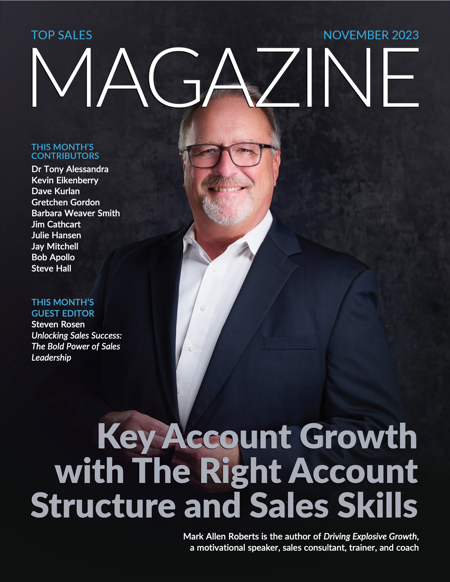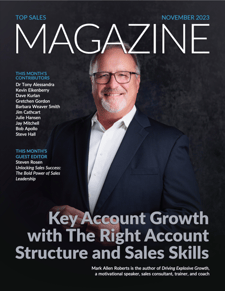Which accounts have the greatest growth potential?
November 7, 2023

 This blog was originally published in the November edition of Top Sales Magazine. You can find a link to their website at the bottom of this article.
This blog was originally published in the November edition of Top Sales Magazine. You can find a link to their website at the bottom of this article.
It has been well established that it is - in most normal circumstances - easier to generate additional business from existing customers rather than from finding and winning brand new customers. These projects also typically tend to have the benefits of shorter sales cycles and more predictable close dates.
Of course, our organisation’s long-term growth depends on maintaining an appropriate balance of new and existing customer revenues - we can’t rely simply on “milking the base” - but what are the keys to making the most of the growth potential of our existing accounts?
This must surely start by making sure that we develop a well-deserved reputation for delivering on our previous promises, and for ensuring that our customer always achieves the business outcomes they set out to accomplish. Winning incremental business is way harder if we have blotted our copybook.
Conversely, uncovering new opportunities is far easier when we can rely on positive internal references. So, if we have any open issues with existing projects, we had better fix them - and be seen to have fixed them.
Assessing the theoretical potential of the relationship
We need to recognise that some of our existing accounts will not have any significant growth potential. This might be because we have already addressed all the potential upsell and cross-sell opportunities. In such cases, we need to focus on retaining and renewing.
But it’s probable that other accounts will still have significant apparent growth potential. This could come from cross-selling or upselling into existing departments, or from entering new functional or geographical areas.
In order to assess the apparent opportunity, we’ll need to map our potential offerings with the customer’s existing patterns of usage. We need to identify “white space” opportunities where there is an apparent need but no current solution, as well as “grey space” opportunities where there is an incumbent current supplier that could potentially be displaced.
This exercise can help to establish the theoretical growth potential of each account. If we are looking at “white space”, we need to establish what priority the customer attaches to dealing with the issues we are able to address. If we are looking at “grey space”, we need to make an informed judgement about how easy it would be to displace the incumbent, and what sort of relationship that vendor has with the account.
Being realistic about the actual potential of the account
In addition to ensuring we have a positive reputation within the account, we also need to assess what sort of relationship we currently have with each account, on a 4-point scale:
- LEVEL 1: We are one of many suppliers or options in our space
- LEVEL 2: We are one of a few preferred suppliers in our space
- LEVEL 3: We are their primary or exclusive supplier in our space
- LEVEL 4: We are their long-term strategic partner in our space
It is the customer's assessment that matters, and not ours. Clearly, when we are currently operating at one of the more strategic levels, it is going to be far easier to find and win new projects than if we are only seen as a tactical supplier.
It is very important that we don’t fool ourselves into believing that we are more important to the account than we actually are, and that we are similarly clear-eyed about what the realistic potential of the relationship could be in the future.
But if we do have the potential to strengthen the relationship, then it must surely be worth investing in developing relationships with the key stakeholders, which leads me to the next point ...
Building our relationships with key stakeholders
We have a much better chance of being invited to bid for new projects if we have already developed strong relationships with the key stakeholders. This has a number of important implications - first, we need to proactively identify and engage the likely key stakeholders in any of the white or grey spaces that we hope to occupy in the future.
Of course, we will want to identify any current active projects in these new spaces, but our chances of winning in new business areas will be dramatically improved if we actively engage the relevant stakeholders before any project is formalised.
This means reaching out on an issue-led basis and sharing information that stimulates the interest of these stakeholders and motivates them to want to learn more. It means familiarising ourselves with the business issues and priorities they are likely to be concerned about.
And, of course, it requires that we become familiar with the experiences of other similar roles in similar situations and can share credible anecdotes about the journeys they have undertaken. These stories are invariably more persuasive and more powerful than simply trying to pitch our company or our offerings.
There is a very significant principle at work here: if we wish to engage the attention of busy executives, we must always seek to lead towards our solution, rather than with it. There will be plenty of time to educate them on our offerings after we have established their interest in the issues we are confident we can help them to address.
In summary
If we want to maximise the potential of our existing accounts, we must ensure we have a deserved positive reputation, and focus on building the right relationships. The projects will surely follow.
Subscribe to Top Sales Magazine
You can subscribe to Top Sales Magazine here.
About the Author
 Bob Apollo is a Fellow of the Institute of Sales Professionals, a founding contributor to the International Journal of Sales Transformation, a recognised Sales Futurist, and the driving force behind Inflexion-Point Strategy Partners, the leading proponents of outcome-centric selling.
Bob Apollo is a Fellow of the Institute of Sales Professionals, a founding contributor to the International Journal of Sales Transformation, a recognised Sales Futurist, and the driving force behind Inflexion-Point Strategy Partners, the leading proponents of outcome-centric selling.
Following a successful corporate career spanning start-ups, scale-ups and market leaders, Bob now works as a strategic advisor, mentor, trainer and coach to ambitious B2B sales organisations - teaching them how to differentiate themselves through their provably superior approach to achieving their customer's desired outcomes.


Comments